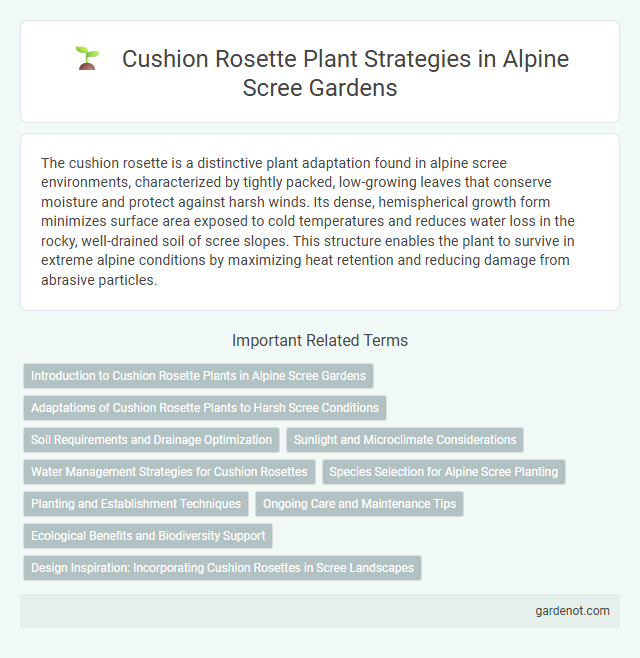The cushion rosette is a distinctive plant adaptation found in alpine scree environments, characterized by tightly packed, low-growing leaves that conserve moisture and protect against harsh winds. Its dense, hemispherical growth form minimizes surface area exposed to cold temperatures and reduces water loss in the rocky, well-drained soil of scree slopes. This structure enables the plant to survive in extreme alpine conditions by maximizing heat retention and reducing damage from abrasive particles.
Introduction to Cushion Rosette Plants in Alpine Scree Gardens
Cushion rosette plants thrive in alpine scree environments by forming dense, low-growing mats that conserve moisture and protect roots from extreme temperatures. These plants exhibit tightly packed, succulent-like leaves arranged in a rosette pattern, optimizing sunlight capture and minimizing wind exposure. Their adaptability to well-drained, rocky soils makes them essential for stabilizing scree slopes and supporting alpine biodiversity.
Adaptations of Cushion Rosette Plants to Harsh Scree Conditions
Cushion rosette plants exhibit dense, low-growing mats that minimize exposure to strong winds and reduce water loss in Alpine scree environments. Their tightly packed leaves create a microhabitat that maintains humidity and protects meristems from freezing temperatures and abrasive debris. These adaptations optimize survival in nutrient-poor, unstable, and highly exposed scree slopes characterized by extreme temperature fluctuations and limited soil moisture.
Soil Requirements and Drainage Optimization
Cushion rosettes thrive in well-drained, gritty soils that mimic their natural alpine scree habitats, preventing water retention and root rot. Optimal drainage is achieved through the inclusion of coarse sand and small gravel, which enhance aeration and reduce moisture accumulation. Maintaining a slightly acidic to neutral pH supports nutrient uptake and overall plant health in these specialized soil conditions.
Sunlight and Microclimate Considerations
Cushion rosette plants thrive on alpine scree by maximizing sunlight exposure through their compact, domed structure that reduces heat loss and captures warmth in cold microclimates. Their tight leaf arrangement minimizes wind desiccation and retains moisture, creating a favorable microenvironment for photosynthesis. These adaptations enable survival in high-altitude scree slopes with intense sunlight and fluctuating temperatures.
Water Management Strategies for Cushion Rosettes
Cushion rosettes in alpine scree environments employ water management strategies such as tightly packed leaf arrangements that reduce transpiration and trap moisture from fog and dew. Their convex shape minimizes water runoff while maximizing water absorption, enabling survival in nutrient-poor, arid conditions. These adaptations optimize hydration efficiency, crucial for enduring harsh alpine climates with limited water availability.
Species Selection for Alpine Scree Planting
Cushion rosette species, such as Silene acaulis and Androsace alpina, are ideal for alpine scree planting due to their compact growth and high tolerance to extreme conditions. These plants exhibit low water requirements and rapid drainage adaptation, making them perfect for the unstable, rocky substrate of scree slopes. Selecting cushion rosette species enhances soil stabilization and supports biodiversity within harsh alpine environments.
Planting and Establishment Techniques
Cushion rosettes thrive in alpine scree environments by requiring well-draining, gritty substrates that mimic natural rocky slopes. Successful planting techniques include placing seedlings in crevices or shallow pits to enhance root anchorage and moisture retention. Establishing these plants often involves minimal watering and protection from extreme frost during the initial growth phase to ensure adaptation to harsh alpine conditions.
Ongoing Care and Maintenance Tips
Cushion rosette plants in alpine scree environments require careful ongoing care to preserve their compact growth and vibrant foliage. Regular removal of dead leaves and debris prevents fungal infections and promotes air circulation, while occasional light watering during dry spells supports their drought-tolerant nature. Ensuring well-drained, gritty soil and avoiding overwatering are essential maintenance practices to mimic natural alpine conditions and sustain healthy cushion rosette development.
Ecological Benefits and Biodiversity Support
Cushion rosettes in alpine scree provide crucial ecological benefits by stabilizing soil and reducing erosion in harsh mountain environments. Their dense, compact growth creates microhabitats that support a diverse range of invertebrates, algae, and microorganisms. These plants enhance biodiversity by offering shelter and moisture retention, promoting the survival of specialized alpine species.
Design Inspiration: Incorporating Cushion Rosettes in Scree Landscapes
Cushion rosettes, characterized by their dense, compact growth and succulent leaves, serve as a natural design inspiration for alpine scree landscapes, mimicking the protective adaptations plants develop to thrive in harsh, well-drained environments. Integrating cushion rosettes in garden design enhances stability and visual texture, while promoting biodiversity by providing microhabitats for alpine flora and fauna. These rosettes optimize moisture retention and soil consolidation, essential for maintaining the delicate balance of scree ecosystems.
Cushion rosette Infographic

 gardenot.com
gardenot.com